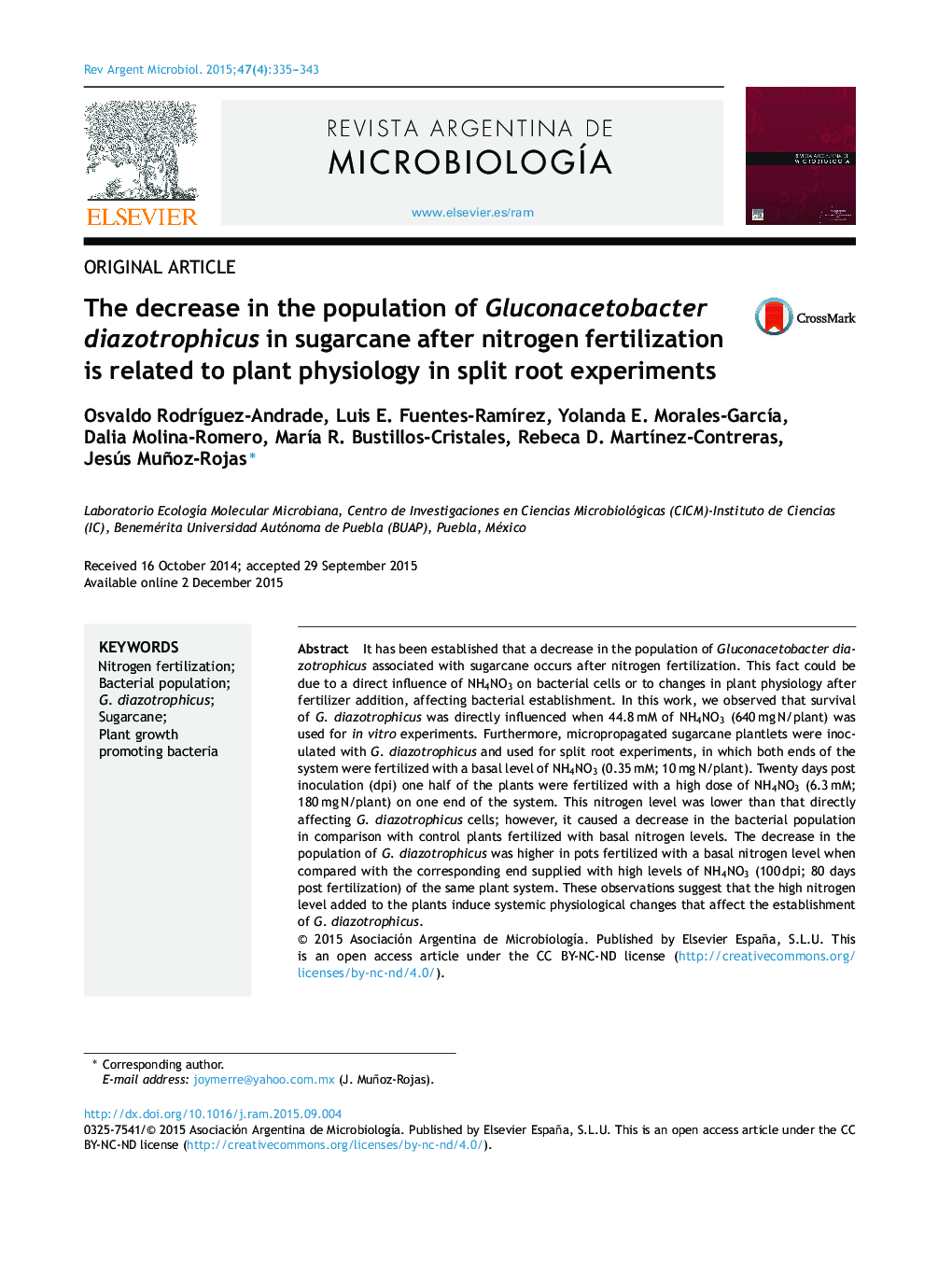| کد مقاله | کد نشریه | سال انتشار | مقاله انگلیسی | نسخه تمام متن |
|---|---|---|---|---|
| 4370522 | 1302404 | 2015 | 9 صفحه PDF | دانلود رایگان |
It has been established that a decrease in the population of Gluconacetobacter diazotrophicus associated with sugarcane occurs after nitrogen fertilization. This fact could be due to a direct influence of NH4NO3 on bacterial cells or to changes in plant physiology after fertilizer addition, affecting bacterial establishment. In this work, we observed that survival of G. diazotrophicus was directly influenced when 44.8 mM of NH4NO3 (640 mg N/plant) was used for in vitro experiments. Furthermore, micropropagated sugarcane plantlets were inoculated with G. diazotrophicus and used for split root experiments, in which both ends of the system were fertilized with a basal level of NH4NO3 (0.35 mM; 10 mg N/plant). Twenty days post inoculation (dpi) one half of the plants were fertilized with a high dose of NH4NO3 (6.3 mM; 180 mg N/plant) on one end of the system. This nitrogen level was lower than that directly affecting G. diazotrophicus cells; however, it caused a decrease in the bacterial population in comparison with control plants fertilized with basal nitrogen levels. The decrease in the population of G. diazotrophicus was higher in pots fertilized with a basal nitrogen level when compared with the corresponding end supplied with high levels of NH4NO3 (100 dpi; 80 days post fertilization) of the same plant system. These observations suggest that the high nitrogen level added to the plants induce systemic physiological changes that affect the establishment of G. diazotrophicus.
ResumenLa población de Gluconacetobacter diazotrophicus asociada a la caña de azúcar disminuye después de la fertilización nitrogenada, lo cual podría ocurrir por la influencia directa del NH4NO3 sobre la supervivencia bacteriana, o por cambios en la fisiología de las plantas, que impiden el establecimiento bacteriano. En el presente trabajo se observó que en experimentos in vitro la supervivencia de G. diazotrophicus fue influenciada por 44,8 mM de NH4NO3 (640 mg N/plant). Además, G. diazotrophicus fue inoculado en plántulas micropropagadas de caña de azúcar, que fueron usadas para realizar experimentos de raíz dividida, en las que ambos extremos de los sistemas se fertilizaron con un nivel basal de NH4NO3 (0,35 mM; 10 mg N/planta). A los 20 días posteriores a la inoculación (dpi), la mitad de plantas fueron fertilizadas en uno de sus extremos con una dosis elevada de NH4NO3 (6,3 mM; 180 mg of N/plant). Este nivel fue menor al que afectó directamente a las células de G. diazotrophicus; sin embargo, provocó una disminución de la población bacteriana en comparación con plantas testigo fertilizadas con niveles basales de nitrógeno. La disminución de la población fue mayor para raíces fertilizadas con un nivel basal de nitrógeno en comparación con las raíces fertilizadas con altos niveles del mismo sistema de plantas (100 dpi; 80 días posfertilización). Estas observaciones indican que el alto nivel de nitrógeno añadido a las plantas inducen cambios fisiológicos sistémicos que afectan el establecimiento de G. diazotrophicus.
Journal: Revista Argentina de Microbiología - Volume 47, Issue 4, October–December 2015, Pages 335–343
